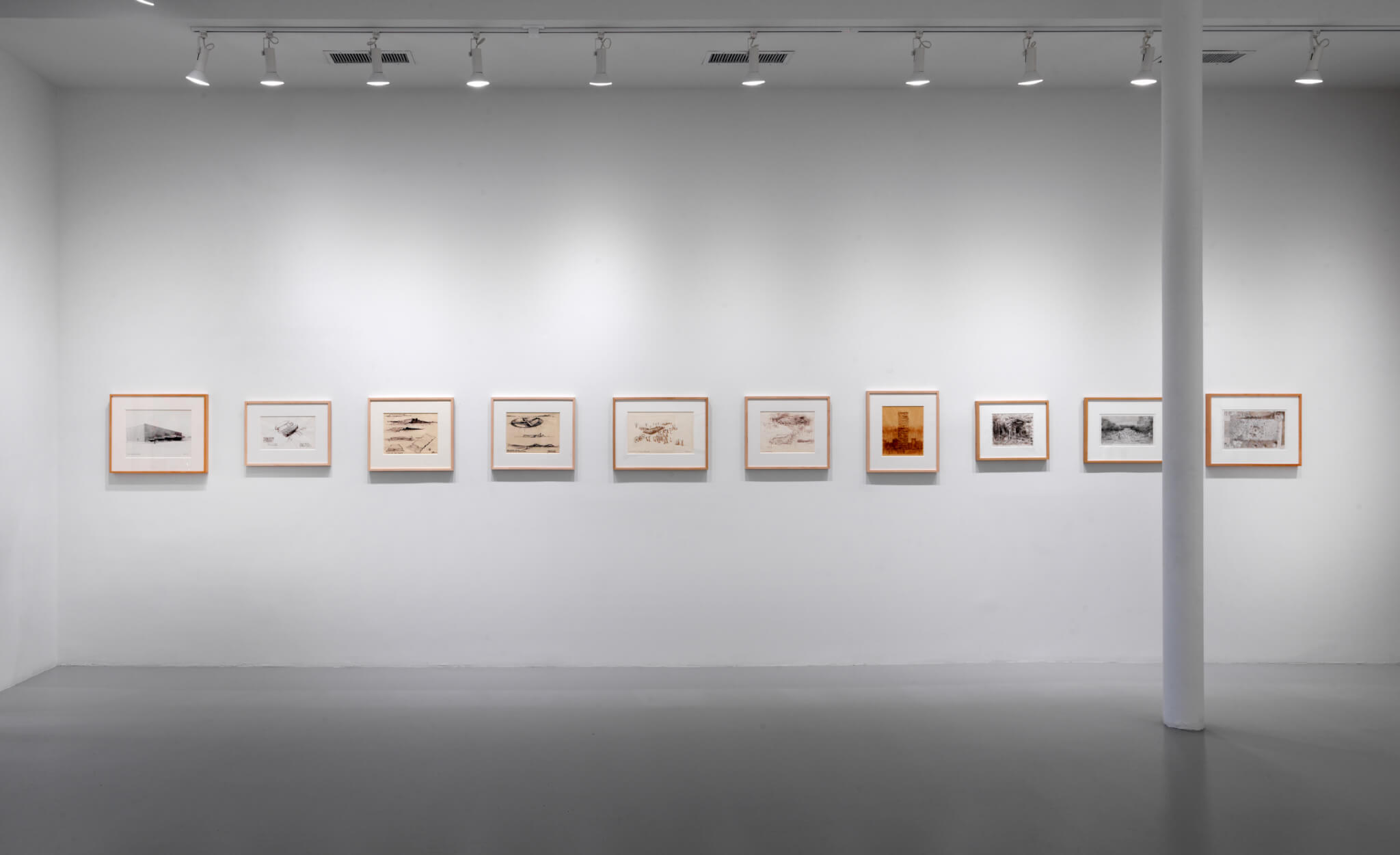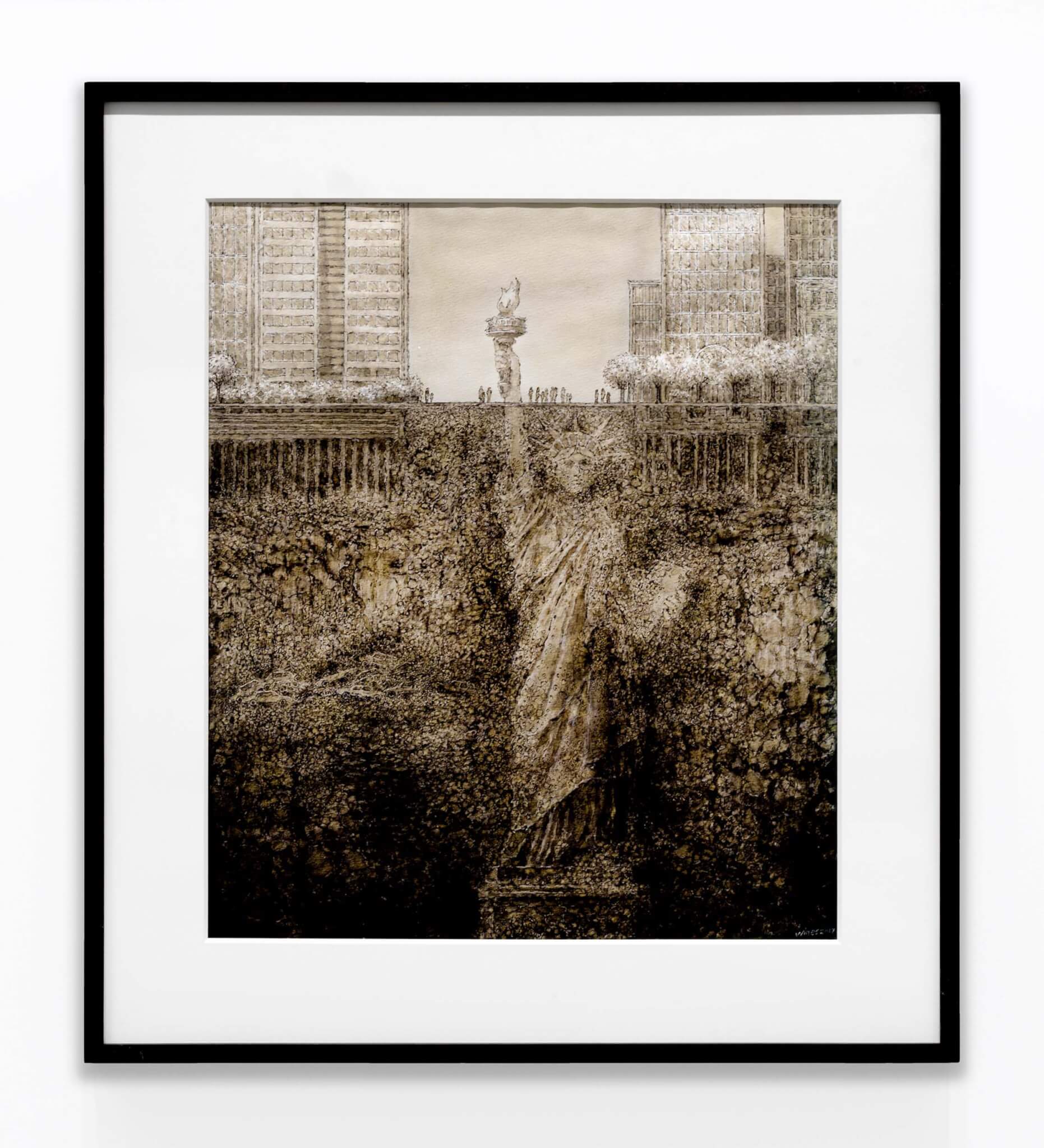Nature’s Revenge
Rhona Hoffman Gallery
1711 West Chicago Avenue
Chicago, IL 60622
Through February 11
Our era of the Anthropocene is one of never-ending casualties: Humans perish under “once in a generation” weather events nearly yearly, and species collapse is all around us. Meanwhile, Architecture responds with press releases for new, lavish office towers that undoubtedly reach net-zero status. The renderings show sparklingly clear glass, ready to contribute to the 1 billion birds that die each year from window collisions. And you learn at the end of the description that whole “net-zero” achievement was made possible through carbon offsets. “Cool, cool, cool,” we all whisper, a small prayer in the face of burning world that won’t be fixed by cheery hacks of neoliberal capitalism.
Nature’s Revenge, a new exhibition at Rhona Hoffman Gallery, showcases drawings by architect and artist James Wines. Installed in a book-like arrangement within the gallery’s main exhibition space, each work addresses such environmental catastrophe and claim to provide an alternative to lavish solutionism. Wines founded SITE (Sculpture in the Environment) in response to the 1970s environmental art movement and the need for responsive green design. Though the exhibition scans as a retrospective of Wines’s interdisciplinary career, his recent drawings present a departure from architecture as climate solution and present a darker, more sinister future.


Wines’s earlier drawings preponderate the exhibition. Specifically, architectural work produced for Best Products, for which Wines designed several commercial store buildings, are famously inventive. One, for Dallas, unfurls a parking lot that traverses upward to become the building’s rooftop (1976), and a showroom with a series of scaling-up awnings (1978) represent his “sculpture as architecture” aesthetic. His Best Products “forest building” for Richmond, Virginia, embedded into green landscape (1978), begins to make more immediate connections between natural ecologies and the built structure. An earlier drawing called Four Corners Project Jeffersonian Grid-Indian Memorial (1974) displays a monochromatic sketch of a landscaped monument which seem to reference Robert Smithson’s mounds and voids.


Some of his works in color, like the Shinwa Resort Hotel (1990) and Windsor Waterfront Park (1991), seem more straight ahead, as their verdant designed landscapes feel a bit heavy-handed and lack the playfulness of sculptural experimentations from the 1970s. Perhaps, too, they land too close to traditional architectural illustrations that attempt to manifest “green luxury.”
Other earlier works include Izuzu Space Station Plaza at the ‘89 Expo (undated), a drawing for a public plaza in Yokohama in which human bodies sprout from the ground feet-first, and abandoned cars are half-sunk into the earth; a bicycle’s wheels are all that’s left of a rider’s sojourn, and leafless trees stand guard over the wreckage. In images of the completed project, children cheerily climb on the stick-straight legs of the victims, playing amongst remnants of a disaster.
But perhaps it wasn’t a disaster that consumed the people of Izuzu; maybe, instead, these disembodies legs are of those who preferred to keep their heads in the sand. Catastrophe or willful ignorance, the Izuzu plaza project foregrounds his most recent drawings and speak to the show’s title.

Two drawings—Lady Liberty Landfill Plaza (2017) and Nature’s Revenge: NYC 2050, View from the Lower East Side (2022)—stand out: The former depicts the Statue of Liberty submerged in the city’s refuse, with only her torch is visible on the street. The incredible textures created with pen and ink wash resemble black mold bubbling on the paper’s surface, adding to the sense of decay. The latter, an image of New York rendered abandoned to the elements, is composed of shadows and voids; wobbly ink scribbles demarcate the flourishing plant life as it consumes buildings and streets.
These drawings are decidedly not architecture; instead, they drift into a speculative fiction that feels less fictional every day. But that’s precisely why the proposals are far more invigorating than, say, product showrooms or a well-landscaped hotel. Through these recent works, Wines, now 90 years young, laughs in the face of our press releases and glittering renderings; though sly and well-drawn, the scenes are an acknowledgement of design’s limitations. They offer futility in the face of impending demise alongside the admittance that we will consume ourselves into oblivion.
Anjulie Rao is a journalist and critic covering the built environment.











